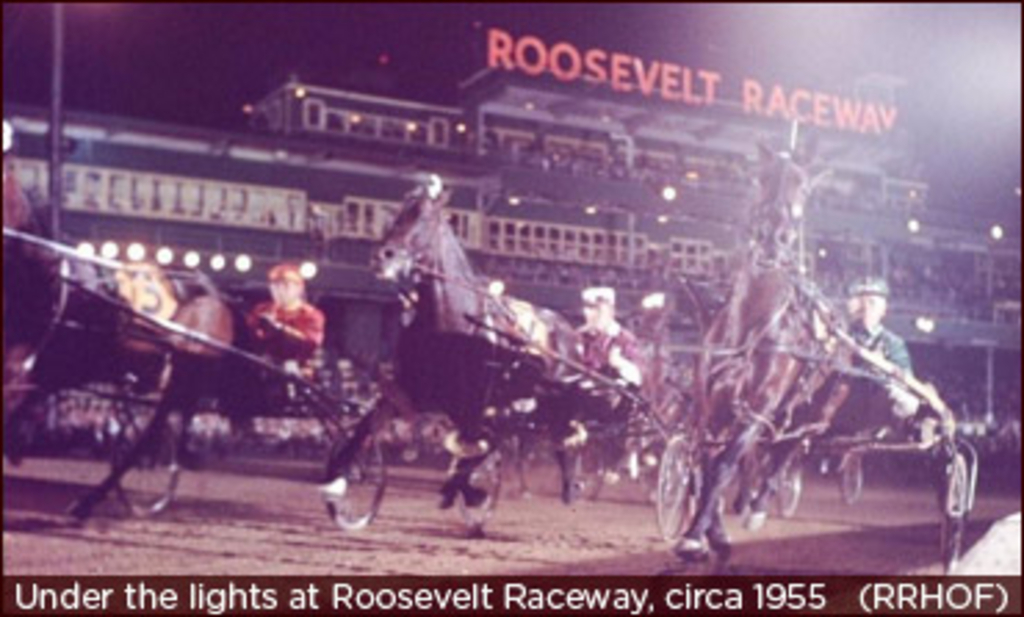SC Rewind: The Dawning Of Night Racing

Robert Smith recalls one of the most important happenings in the growth of early harness racing and how it helped launch the sport into big league status
.
An important milestone in harness racing history is about to occur but is quite likely to go unnoticed by all but a few. On the evening of September 2, 1940 the first program of night time harness racing was held at Roosevelt Raceway in Westbury, Long Island New York. It is considered to be the beginning of the modern era of harness racing as we know it today. Racing under the arc lights had been tried before, but this was the start of its continuous existence, which now quietly celebrates its 70th birthday.
Night harness racing was tried as far back as the early 1900's when Combination Park in Boston, Massachusetts was lighted. The venture was a failure and lights weren't used again until 1928 when they received another brief but ill-fated try at Toledo, Ohio. On our side of the border, an enthusiastic gentleman named Charlie Crummer of Chatham, ON also attempted to string a few lights around his hometown track but this project was also a failure. Other short-lived experiments occurred elsewhere.
It remained for the management of Roosevelt Raceway under the direction of Mr. George Morton Levy to test the night racing idea in another era and to find that it would catch on if properly promoted. While the project was a success, the track went through many tough days and nights before the sport came into the prominence it was to eventually enjoy. Opening night attracted some 5,000 fans eager to see what this new format was all about. They wagered $40,472 on an eight-race card with the very first race won by Martha Lee, who I believe was a Canadian horse. While a wealth of happy memories were associated with opening night, a bit of sadness intervened as well when Miss June won the fifth race but immediately collapsed and dropped dead on the track. With WWII in progress, attendance was often low and profits were minimal but perseverance eventually paid off.
By 1950 the crowds came in droves and nightly mutuel handles in excess of $1 million became a regular occurrence. The era of night time racing had truly arrived. Attendance figures escalated and in 1960 a record crowd of 54,861 showed up to see that year's International Trot. That set a record for attendance at a U.S. harness racing event. Roosevelt was also home to many great annual classics including The Messenger Stakes, part of the Triple Crown.
The site of Roosevelt Raceway was in the Hempstead Plains area and located less than a half-mile from where the famous flight of Charles Lindbergh began as he made the first transatlantic flight. The actual location was part of the Roosevelt Air Field and was first home to an auto racetrack built in 1936 best remembered as hosting the short lived Vanderbilt Cup. Also of historical significance is that Newmarket Course the first horse racing track in North America was once nearby.
In time, each great horse, driver and trainer eventually made their way to the "Top" and the top was Roosevelt. In the earliest days, Canadian drivers such as Clint Hodgins, Joe O'Brien, Morris MacDonald, Floyd Milton, Bill Harvey and many others tried their luck on the big stage. I can recall discussing that first year with Harold Wellwood Sr., who remembered shipping horses via rail due to wartime restrictions. One of his stable stars was Jackson Henley, a $75 reclamation project from the Amish at Elmira, ON. Later the names of Lucien Fontaine, Johnny Chapman, Bud Gilmour, Herve Filion and many more gravitated to the Big Apple. They joined all of the great U.S. drivers of several eras with the names of Haughton, Miller, Dancer, Simpson, Cruise, Abatiello, Bell and Jordan. It was a simple fact that if you had the talent, both human and equine, there was no other place as prestigious and profitable on the continent.
As the years rolled on, Roosevelt continued to prosper and old facilities and structures were replaced with state of the art designs. At one time two restaurants, air conditioned viewing areas, ultra modern tote boards and even an on site hospital existed. In the mid 1950's a complete facelift, which included a new grandstand replacing the old Vanderbilt relic, took place without interrupting the racing schedule. It was referred to as the "Dream Track," costing $20 million just a "tad" over the estimate of $10 million!
Roosevelt began to experience a decrease in attendance and wagering as early as 1971 when off track betting began to affect all New York State tracks. Also the tremendous rise in land values, which rose to $200 million, made the raceway property more attractive for other purposes. Gradually over the next two decades a steady decline took place and the decision was made to close the facility. The last race in the track's almost 48-year history took place on July 15, 1988. It was a sad day for several generations of fans, horse people and the sport itself.
Today little remains of Roosevelt Raceway beyond its name. A shopping centre and movie theatre now stand where the parking lot existed for all those years. A bright orange Home Depot occupies the land which was once home to the stables. A luxury condominium complex called Meadow Brook Commons sits on the former site of the grandstand where millions once cheered their favourites to the finish line right where it all began.

